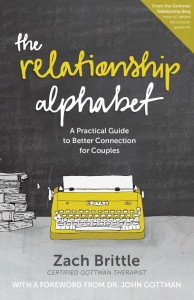Zach Brittle, a 2001 MA in Counseling graduate of The Seattle School and a Certified Gottman Therapist with more than 10 years of experience working with couples, has recently published a new book—The Relationship Alphabet: A Practical Guide to Better Connection for Couples. We’re thrilled to offer the following excerpt from the book, which you can read more about here. And don’t miss the previous two excerpts, “I is for Imagination” and “P is for Problems.”
I’m writing this chapter in October, which is Domestic Violence Awareness month. I appreciate that we as a country have devoted a month to such an important issue, although unfortunately I think it’s something we’re already quite aware of these days, even without the reminder. At the moment, there’s a powerful ad campaign for a nonprofit called No More, wherein television personalities and NFL players call for a stop to domestic violence. The ad features football players largely because multiple stories have recently surfaced about prominent athletes (in the NFL and beyond) accused and/or convicted of domestic violence. If you’re a therapist, you’ve heard such stories in your office more often than you’d care to admit, and not just in October. Even if you’re not paying attention, you must know that domestic violence awareness isn’t important simply because the media says so.
It’s a tough topic. Not for the faint of heart. And I fear that, due to word-count constraints, I won’t be able to bring the proper gravitas to the experiences of the one in three American women who are abused each year. In the time it takes me to write this sentence, another woman will be assaulted or beaten in the U.S. Just typing those words makes me feel powerless, but not nearly as powerless as the 1.3 million women who will be assaulted by a partner this year.
The observant reader will note that I haven’t even scratched the surface with regard to violence perpetrated against women and children worldwide. You might also be inclined to remind me that 85 percent of adult domestic violence victims are women. I could, and maybe I should, dedicate 15 percent of my word count to the very real plight of abused men. But the point is that these statistics—these stories—are tragic. And perhaps we’re not as powerless as we think.
 As a therapist, I find the question of how to assess violence a tricky one. Research suggests that half of all couples seeking therapy have experienced violence in their relationship, whether they tell you or not. In some cases, when there’s violence in the relationship, therapy can do more harm than good. In any case, it is important to distinguish between violence and battery. In Treating Men Who Batter, Dr. Anne Ganley defines battery as follows:
As a therapist, I find the question of how to assess violence a tricky one. Research suggests that half of all couples seeking therapy have experienced violence in their relationship, whether they tell you or not. In some cases, when there’s violence in the relationship, therapy can do more harm than good. In any case, it is important to distinguish between violence and battery. In Treating Men Who Batter, Dr. Anne Ganley defines battery as follows:
Battery is a form of abuse where the primary aggressor employs violence ranging from pushing to relationship rape to homicide, to enhance the aggressor’s control over their partner, leading the partner to modify their behaviors in daily life. It is meant to instill fear and intimidation.
When battery is present, couples therapy is inappropriate. Identify and provide appropriate referrals for your client(s). Battery is evidence of what Dr. Gottman calls Characterological Violence, where one partner clearly demonstrates controlling and dominating behavior. In this case, your client is in clear and immediate danger, and you have a responsibility to refer him or her to a treatment center, hotline, shelter, specialist, or the police. If you suspect battery is present but one or both partners are denying it, refer. If you’re not sure, refer. It’s irresponsible, unethical, and likely even illegal for you to begin couples therapy when Characterological Violence is present.
But what about when violence is more subtle—what Dr. Gottman calls Situational Violence? Situational violence occurs most often with couples who lack conflict resolution skills. Generally both partners feel remorse, understand the impact, and internalize the blame. In this case, treatment for the couple prioritizes conflict management, with an emphasis on flooding and repair. The couple must also learn to recognize and rein in the “Four Horsemen” (criticism, contempt, defensiveness, stonewalling) so that conflict does not escalate. Eventually the therapist should help the couple replace toxic conflict patterns with a deeper sense of friendship and shared meaning. I have intentionally not gone into detail here because my goal is not to train therapists as much as to raise awareness. Also, therapists aren’t necessarily my audience just now. If you are a therapist and do want to talk about this, my contact information is available here. Please reach out to me.
Many of you reading this are wondering what to do about your own relationship. You may be wondering if there’s hope or help. There is. No doubt your community has resources available to you, and you can also contact the National Domestic Violence Hotline (1-800-799-7233, 1-800-787-3224, or thehotline.org). You may be wondering if what you’re experiencing is characterological or situational violence. If you’re not sure, I suspect it’s more severe. Domestic violence is never the victim’s fault. Seek help.
If you’re certain that you and your partner are simply bad at conflict, then get better at it. Remember that you are adults. You have a responsibility to behave like adults. When conflict escalates in your relationship:
- Self-Soothe When Flooded: This is the first step to conflict regulation. “Flooding,” in the Gottman lexicon, refers to that feeling of being completely emotionally overwhelmed during a conflict. It often comes with physical indicators. Do you feel shaky or lightheaded? Is your pulse racing, like 95 beats per minute or higher? If so, take a break. Try 10-15 deep breaths. Go for a walk. You simply cannot engage your partner in a meaningful way when you are flooded, so give yourself time to calm down.
- Identify your Common Enemy: Situational violence occurs when partners identify one another as the enemy. This is a bad strategy. You need to define your common enemy—in this case, it could be the violence itself. When negativity rises up, remember you have a responsibility (and literally, response-ability) to deny it access to your relationship. Identifying a common enemy helps you become more attuned to each other’s needs so that you can fight with, not against, one another.
- Practice Repair: Repair is any statement or action—silly or otherwise—that prevents negativity from escalating out of control. It’s an advanced skill for couples, but skills can be learned. You’ve heard the phrase, “practice makes perfect”? I actually disagree. Practice makes permanent. If you practice poor conflict management, it’ll become permanent. Practicing repair shifts the balance away from the conflict and toward the couple. Get creative.
Whether you are a therapist or a client, a victim or an abuser, a running back or a goalkeeper, you can do something about domestic violence. It’s a solvable problem. It begins with awareness (thanks October) but it requires attention and action. Pay attention. Act. Ask for help. Respond.
You are not powerless.
Discussion Questions:
- How might characterological violence look different from situational violence?
- Do you agree that situational violence can respond to therapy, while characterological violence requires immediate removal from the situation? Why or why not?
- Can you remember a time you felt “flooded” during a conflict? How did you respond? What was the result?
- If situational violence exists in your relationship, what techniques can you implement today to work toward better conflict resolution? If violence does not exist in your relationship, what skills can you sharpen to ensure it stays that way? (In either case, it may be helpful to reread “R is for Repair.”)
- Think about a recent conflict you had with your partner. What do you think was the “common enemy” in that particular case? Did you identify it during the conflict? Why or why not?

